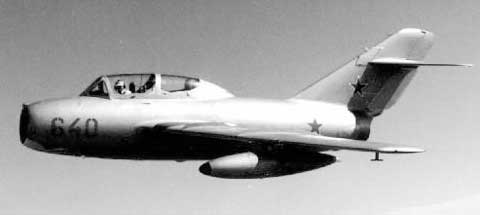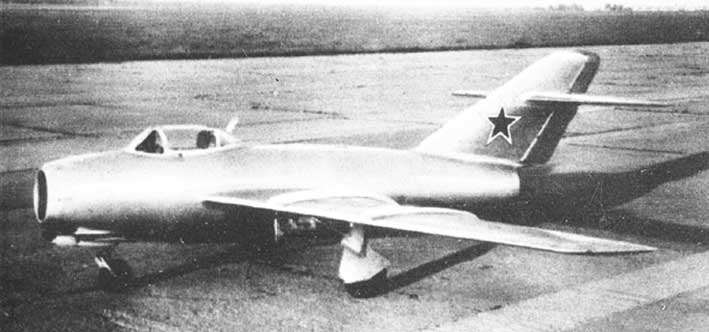The Mig I-310 was of a conventional layout,
heavily influenced by German research on aeronautics and considered to be
the best compromise by the Mig OKB, however it was a indigenous Soviet design.
It consisted of mid mounted 35° swept wings, with the main undercarriage
fitting into them, a short circular section fuselage which housed a pressurized
cockpit with an ejection seat, engine and a large T-tail, the only real
problem was the engine. The choice was between an Axial-flow design based
on a German design and a centrifugal design based this time on the British
"Nean" engine (VK-1PO). In the end the centrifugal engine was chosen. 
|
Fortuitously as it turned out, as in September 1946 the
British agreed the export 10 "Nean" engine to the USSR at once, with a
further 15 in March 1947 and more to follow. By the end of October 1946
the Soviets were issuing production drawing of the "Nean" to No 45
Production Factory for production (the "new" engine being designated RD-45
after the factory) with Mig receiving full installation drawing for the
engine by February 1947.
The first prototype (S-01) was finished on the 27/11/1947
with the first flight being on the 30/12/1947, flown by Vikitor
Nikolayevich Yuganov. A number of changes were made such as the increasing
of the tail plane sweep to 40° from 35°, the cutting back of the rear
fuselage to shorten the the jet pipe by 320mm. The second prototype (S-02)
was fitted with the more powerful Nean-2 engine, with the third aircraft
(S-03) having all of the above modification as well as airbrakes installed
to the rear of a strengthened fuselage and hard points under the wings and
armament fitted. This aircraft took to the air on 17/6/1948 and was
extremely successful in testing and in August 1948 the design was given
the go ahead for production, by 1956 a staggering 12,000 had been made in
all versions and it was in use in the 1990's around the world as a
trainer, the Mig-15 UTI. |



